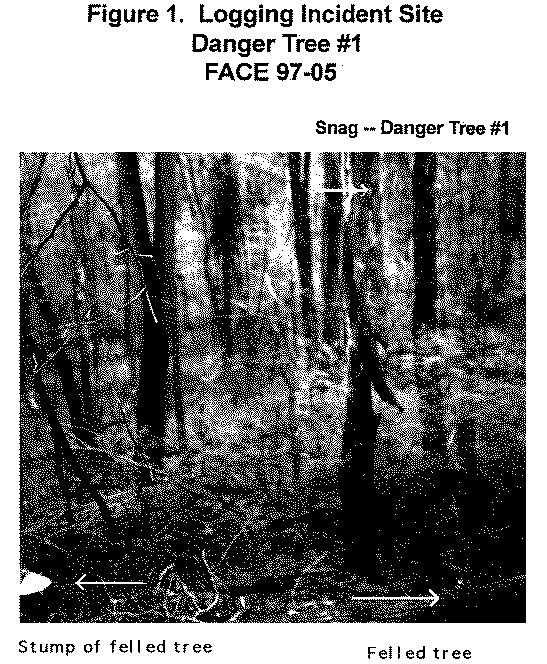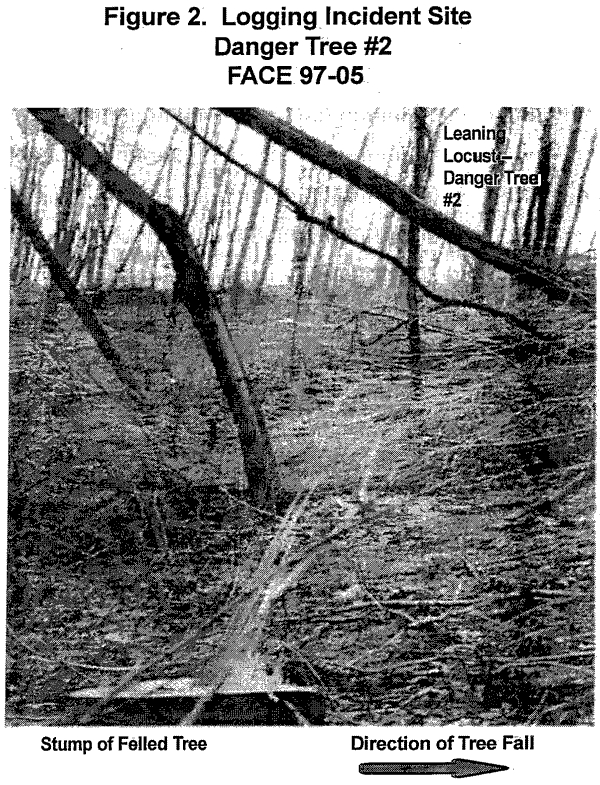Hog Farmer/Logging Company Owner Dies After Being Struck by a Falling Tree-West Virginia
FACE 9705
SUMMARY
A 35-year-old male hog farmer/logging company owner (the victim) had just completed felling a yellow poplar tree at a rural logging site when he was struck and killed by the falling tree. The victim and a co-worker were performing separate logging tasks when the incident occurred. The co-worker was operating a skidder, while the victim was felling trees within the same work area. Using a chainsaw, the victim made an undercut on one side of a 70-foot-high yellow poplar tree; he then moved to the opposite side of the tree and made a backcut and the tree began to fall perpendicular to the hillside he was working on. Evidence suggests the victim shut off the saw and set it on the ground, turned his back to the falling tree and began to move away in an uphill direction. As the tree was falling, it struck and glanced off a locust tree about 21 feet away (which altered the direction of the falling tree). The co-worker, who was hooking up a choker to a downed tree, saw the tree fall but was unable to see the victim from his location. He called to the victim; when there was no response, he walked down the hill, and saw the victim trapped beneath the fallen tree. He checked for vital signs, found none, and went for help. An ambulance arrived about 20 minutes after the incident occurred and the victim was pronounced dead at the scene. NIOSH investigators concluded that, to prevent similar occurrences, employers should:
- ensure that tree fellers, a job classification that often includes employers, properly evaluate the area around timber to be felled so that potential hazards can be identified and appropriate control measures implemented
- ensure that workers prepare adequate escape paths and move a safe distance away from the base of the tree as the tree is falling
- develop, implement and enforce a written safety program which includes, but is not limited to, worker training in hazard identification, avoidance and abatement.
INTRODUCTION
On May 2, 1997, a 35-year-old male hog farmer/logging company owner (the victim) was killed when he was struck on the head by a falling tree. On May 2, 1997, a FACE program field investigator from the State of West Virginia contacted the Division of Safety Research (DSR) about this fatality, and requested technical assistance. On May 8, 1997, a safety specialist from DSR and the West Virginia FACE program field investigator conducted an investigation of this incident. The investigators reviewed the incident with the co-worker and a West Virginia State Police Trooper, and examined and photographed the incident site. The medical examiner’s report was requested during the investigation.
The victim in this incident was a hog farmer and small logging company owner with one employee. The employer did not have a written safety program or established safe work procedures at the time of the incident; however, safety concerns were discussed on an infrequent basis. The victim had about 20 years’ experience working in the logging industry. This incident was the first fatality the company had experienced.
INVESTIGATION
The victim and co-worker had jointly purchased the timber rights to a 12-acre tract of land where a variety of 12-inch diameter and larger hardwood trees were to be selectively harvested. After harvesting, the timber would be cut into saw logs and transported to a commercial sawmill. The incident occurred during the third week at the work site. Two workers were present at the work site–a skidder operator (the co-worker), and the company owner/timber cutter (the victim). The terrain where the incident occurred was mountainous with an approximate 30-35 percent slope, and environmental conditions were favorable (i.e., the ground was dry, no wind was present, and temperature was in the 50’s).
On the day of the incident, the victim and co-worker arrived at the landing about 9 a.m. The co-worker began replacing the chain on a chainsaw while the victim drove to the cutting area, about 2- mile away, and commenced felling trees. The victim had felled two trees prior to the incident, which occurred about 9:15 a.m. Evidence at the incident site and conversations with the co-worker and State Police Trooper suggests the victim decided to fell the third tree while positioned on the uphill side. One probable reason the victim selected this location was the presence of a 45 to 50-foot-tall dead standing tree (danger tree #1), which was located 15 feet downhill and slightly in front of the tree to be felled (see Figure 1). Also directly in the path of the tree to be felled was a 50-foot-tall locust tree, 9 inches in diameter at breast height (d.b.h.), that had partially fallen sometime prior to the incident (danger tree #2). The locust was 21 feet away from the tree to be felled and its top was caught in the top of a maple tree about 40 feet away causing the locust to be in a leaning position (see Figure 2). The victim may have considered the locust tree’s position and determined that when the poplar tree fell it would break the locust upon contact. The victim proceeded to cut the yellow poplar tree which was about 70-feet tall and 18-inches d.b.h. He made a standard undercut and then made an appropriate backcut. As the poplar tree was cut through, it started to fall in the direction of the leaning locust tree. The victim apparently shut off the chainsaw and set it on the ground, turned his back toward the falling tree and started moving up the hill. When the falling tree contacted the leaning locust tree, the locust did not break and the falling tree recoiled off the trunk of the leaning locust tree, in an uphill direction. The butt portion of the falling tree struck the victim on the back of the head and pinned him to the ground. The co-worker, who was hooking a choker cable to another downed tree, saw the tree fall and looked for the victim. Not seeing the him, the co-worker called his name. Receiving no answer, he walked about 100 yards down the hill and saw the victim pinned beneath the butt of the fallen tree. The co-worker checked the victim’s pulse and found none, then went for help. An ambulance arrived about 20 minutes after the incident occurred and the victim was pronounced dead at the scene.
CAUSE OF DEATH
The medical examiner’s report listed the cause of death as multiple trauma to the head.
RECOMMENDATIONS/DISCUSSION
Recommendation #1: Employers should ensure that tree fellers, who are often employers, properly evaluate the area around timber to be felled so that potential hazards can be identified and appropriate control measures implemented.
Discussion: Two potential hazards existed which contributed to the incident. One danger tree was located 15 feet downhill and slightly in front of the tree to be felled, and a second danger tree, a leaning locust 9-inches d.b.h., was located 21 feet away and directly in the path of the tree to be felled. 29 CFR 1910.266(h)(1)(vi) and (2) (ii) state respectively “Each danger tree shall be felled, removed or avoided. Each danger tree, including lodged trees and snags, shall be felled or removed using mechanical or other techniques that minimize employee exposure before work is commenced in the area of the danger tree. Also, before each tree is felled, conditions such as, but not limited to, snow and ice accumulation, the wind, the lean of tree, dead limbs, and the location of other trees, shall be evaluated by the feller and precautions taken so a hazard is not created for an employee.” In this case, it appears the victim may have evaluated the area around the tree being felled and decided to position himself on the uphill side of the tree to avoid being hit by broken limbs/tops from danger tree #1 when the poplar tree was felled. However, danger tree #2 (leaning locust) may not have been viewed as a problem since it was further away and appeared dead. Appropriate precautions (e.g., removing the danger trees first) may have been implemented, thereby eliminating the potential hazards.
Recommendation #2: Employers should ensure that workers prepare adequate escape paths and move a safe distance away from the base of the tree as the tree is falling.
Discussion: Although it is unknown whether the victim had prepared an escape path, he turned his back to the falling tree and moved uphill about 12 feet before being struck by the butt of the falling tree. Preparing an adequate escape path before felling any tree is imperative for a safe felling operation. Doing so will allow the feller to quickly reach a safe distance from the falling tree. A way of escape must be planned before felling a tree, and must be kept free of brush, tools, or other obstructions. The route of escape must be clear of the intended direction of the falling tree. Workers must keep at a safe distance from the base of the tree as the tree is falling.
Recommendation #3: Employers should develop, implement and enforce a written safety program which includes, but is not limited to, worker training in hazard identification, avoidance and abatement.
Discussion: The victim was struck and killed by a falling tree that he had just felled. Employers should evaluate tasks performed by workers; identify all potential hazards; and then develop, implement, and enforce written safe work procedures addressing these issues. The safety program should include at a minimum, worker training in hazard identification, and the avoidance and abatement of these hazards.
REFERENCES
Office of the Federal Register: Federal Register, Vol. 59, No. 196, 29 CFR 1910.266, p 51746, Wednesday, October 12, 1994.


